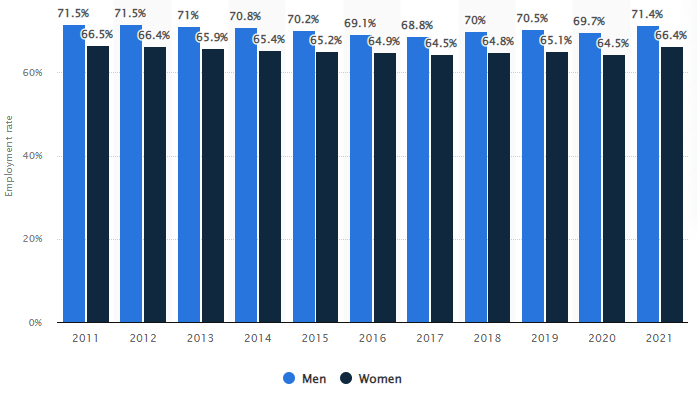The Norwegian etiquette encompasses their greetings, dress codes, designations and introductions and proper negotiation. In Norway, people greet through handshakes, which often follows the issuance of pleasantries or business cards. For dressing codes, both men and women are required to wear suits when attending official occasions but the typical office attire entail smart casual style (Hermann et al., 2021). Besides business attires, Norwegians are required to address people they meet for the first time with their last name. Since workplace gender equality is emphasized in Norway (Figure 1 demonstrates that the difference between the number of employed men and women is insignificant), it is essential to treat females with respect (Ramfjord, n.d.).

Formal Greetings
Greetings in Norway are often casual but done in a respectful way, reflecting the formality of the matter at hand. When making a handshake with a Norwegian businessperson, ensure it is firm and that you make a smile and direct eye contact. After making the handshake, one should introduce themselves with their first name only since Norwegians are egalitarian. If one wants to show status during the meeting, they can refer the other person with honorific titles such as “Herr” which means mister or “Fru” which means miss, followed by their surname (Knodel, 2019). Generally, individuals are required to use second names when referring to Norwegians until they are invited to use the first one.
Formal Handshakes
A Norwegian formal handshake has various characteristics involving time and quality. First, one needs to keep their hands ready for handshakes to avoid sudden greetings, which would send wrong signals to the businessperson. Then, one needs to know when to extend their hands, where if one is meeting senior personnel, they should let the person extend their hands first before making the greeting. Thirdly, there should be sincerity during the handshake, which is achievable by making a direct eye contact and smile to show one’s feelings about the interaction. Further, when greeting the person, an individual should aim the web, which allows them to pump firmly (Knodel, 2019). Lastly, one should keep the pressure moderate and the whole greeting should be brief, lasting for 2 to 4 seconds.
Norwegian Business Gifts
Norwegian business gifts include both physical and non-physical presents that are presented to prospects, clients and employees with the hope of creating a long-lasting connection. When approaching Norwegian individuals and one aspires to offer them gifts, they can present the people with physical items such as t-shirts, personalized notebooks or even tumblers. Additionally, one may choose to offer a non-physical gift, which can entail perks or digital gift cards (Knodel, 2019). One of the key features that the gifts should possess is the branding of the recipient’ business name.
Norwegian Business Gift Cards
The Norwegian business gift cards follow the standard method of designing these forms of appreciations. They hold the value for both the giver and the receiver, allowing for a better trust and connection formation (Orban, 2022). Firstly, the business card needs to entail the company’s and individual’s name and incorporate business address. Thirdly, the gift card needs to show the contact information of the business, which can be a phone number, email address and the organization’s website. Fourthly, Norwegian business cards often have job titles, which acts as a way of showcasing the extensiveness of one’s company. Lastly, the gift card can incorporate a tagline of description, which brands the company and acts as a reminder of who the individual is.
Showing Respect by Following the Business Etiquette
Respect for business etiquette in Norway, especially during meetings can be manifested by various subtle acts. Avoiding arriving late, which makes one avoid leaving colleagues waiting shows that in respects Norway’s business etiquette. Additionally, avoiding the usage of smartphones when conversing or talking with one’s neighbor during meeting can show that one adheres to Norway’s strong corporate etiquette (Hermann et al., 2021). Lastly, avoiding interrupting others and leaving early is a strong indication of respect towards the organization’s etiquette.
References
Hermann, R. R., Amaral, M., & Bossle, M. B. (2021). Integrating problem-based learning with international internships in business education. Journal of Teaching in International Business, 32(3-4), 202-235.
Knodel, L. V. (2019). Business English: Business etiquette and correspondence.
Orban, F. (2022). Living alliances, leaving alliances: Interdisciplinary perspectives. Waxmann Verlag.
Ramfjord, V. (n.d.). Norwegian business culture. Invest in Norway. Web.
Statista. (2022). Employment rate in Norway from 2011 to 2021, by gender. Web.